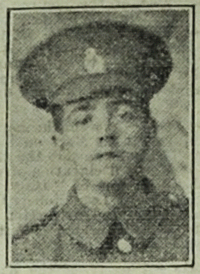Name
James Henry Sewell
1896
Conflict
First World War
Date of Death / Age
31/07/1917
21
Rank, Service Number & Service Details
Corporal
265385
Hertfordshire Regiment
Awards: Service Medals/Honour Awards
1914 /15 Star, British War and Victory medals
Cemetery/Memorial: Name/Reference/Country
YPRES (MENIN GATE) MEMORIAL
Panel 54 and 56.
Belgium
Headstone Inscription
NA
UK & Other Memorials
Hitchin Town Memorial,
4 Co' Hertfordshire Reg' Territorials’ Memorial, Hitchin,
Holy Saviour Church War Memorial, Radcliffe Rd., Hitchin,
Tilehouse St Baptist Church War Memorial, Hitchin,
St Mary's Church Roll of Honour (Book), Hitchin,
British Schools Museum Memorial, Hitchin,
Hertfordshire Regimental Memorial, All Saints Church, Hertford
Pre War
Wartime Service
He was originally Private 2311 and when war was declared he mobilized the next day 5 August 1914. Territorials were only required to serve in the UK, however many volunteered to do so. That included James who volunteered on 21 August 1914. Most of the Herts men who volunteered went to France on the 5th or 6th on November 1914, but that did not include James who did not go to France until 9 July 1915.
He was appointed as Lance Corporal (paid) on 22 December 1914, went to France 9 July 1915 then Acting Corporal 12 August 1915, but reverted to Lance Corporal 30 December and the private 1 March 1916.
We think that he was first wounded in October 1915, but he suffered a gunshot wound to his left arm on 8 July 1916 and returned to the UK on 13 July 1916, then posted to the Reserve Battalion on 24 September – presumably after he recovered and did not return to France until 4 January 1917 and was posted back to 1st Herts on the same day. It would have been soon after this that James was renumbered to 265385.
In early 1917 soldiers who had enlisted or were serving in a Territorial Force regiment were issued with a new, six-digit service number. This was largely related to the huge increase in the numbers of men serving in the infantry regiments and the need to avoid confusion.
A newspaper reported, after his death, that he had been wounded twice James fought at Ypres and Arras before he died at St Julien. "The last seen of him was just before the final objective was reached.”
On this day the 1st Herts were cut to pieces by shot and shell at St. Julien in the Ypres Salient. They had marched from Vlamertinge to their assembly position arriving by midnight on the 30th/31st July 1917.
A general bombardment of the German lines commenced at 3.45am on the 31st July and the Hertfordshires left their assembly position at 5.00am and passed through St. Julian during the morning.
Unfortunately, the promised supporting artillery barrage did not materialise as the guns could not be brought up due to the all -prevailing mud. By noon the Herts had crossed the Steenbeck stream and had come across unbroken wire that prevented any further advance.
The German artillery and machine-guns decimated them and by the end of the day the Herts had virtually ceased to exist. Over half the fighting strength of the Battalion, including most of the officers, were killed or wounded in a single day.
The 1st Hertfordshire Battalion were in support of an attack on the Langemarck Line and a general bombardment of the German lines commenced at 3.45am on the 31st July and and the planned assault began. It had three objectives to achieve known as Blue, Black & Green and units of the 116th Brigade easily captured the first two objectives, preparing the way for the forward companies of the Hertfordshire battalion, to take the third objective.
They had marched from Vlamertinge to their assembly position arriving by midnight on the 30th/31st July 1917. A general bombardment of the German lines commenced at 03.45am on the 31st July. At 05.00am the Hertfordshires left their assembly positions to attack their objective, which lay over the crest of a ridge.
As they made their way forward they came under heavy fire from both German machine guns and snipers but after eliminating a German strongpoint moved up towards St. Juliaan, which was only lightly held. The Battalion crossed the Steenbeek with some difficulty and two of its supporting Tanks became bogged down in the mud. Things then went from bad to worse. A pre-arranged artillery barrage never materialised due to the guns being unable to move forward over the muddy terrain and the German barbed wire defences, which were fifteen feet deep in some places, were found to still be intact. It was soon realised that ground could only be won by section "rushes" supported by the unit’s own fire.
The Cheshire Regiment were on the right of the battalion but the Black Watch, who were due to cover the left flank, had been seriously delayed. This left the Hertfordshire Regiment seriously exposed, the Germans exploited this by bringing a hurricane of fire down upon the stricken troops. This was followed by a German counter-attack and by 10.30am it was clear that the objective could not be achieved. Casualties were very heavy with 459 men being killed, missing or wounded. This was 100% of its Officers and about 75% of its Other Ranks
Additional Information
Acknowledgments
Adrian Dunne, David C Baines, Jonty Wild, Paul Johnson, Derren Brown



